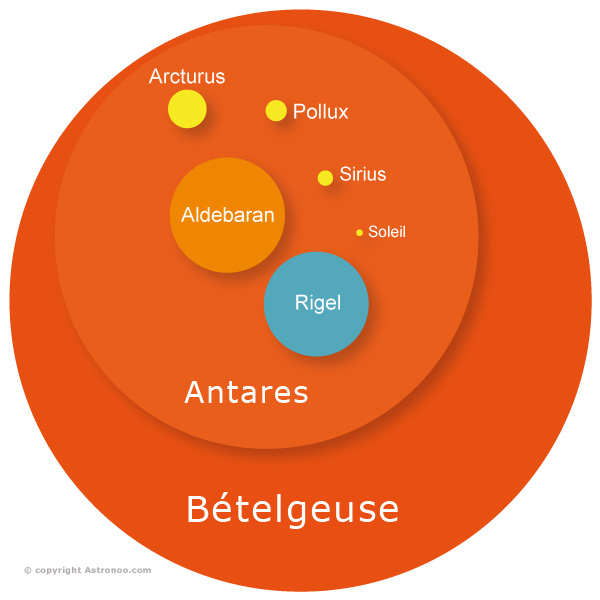
Image description: Globular cluster of Omega Centauri, image taken by the Hubble Space Telescope with the Wide Field Camera 3 (WFC3), in 2009. The color allows the classification of stars according to their spectral type. The spectral types range from the most violet to the most red, that is, from the hottest to the coldest. Image source: NASA, ESA, and the Hubble SM4 ERO Team.
The brightest stars form figures. These groupings differ from one era to another and from one civilization to another. The figures that have become traditional, often related to Greek mythology, are called "Constellations".
The stars of a constellation have nothing in common, except for occupying, as seen from Earth, a neighboring position in the sky. They can be very far from each other. However, the International Astronomical Union has defined a standardized list of constellations, assigning to each one a region of the sky, in order to facilitate the location of celestial objects.
Stars have a mass ranging from about 0.08 to ≈300 times the mass of the Sun. This magnitude determines the life of the star. A very massive star will be very luminous but its lifespan will be reduced because it produces very powerful winds.
Aged a little over a million years, the most extreme star, R136a1, is already halfway through its life and has lost a fifth of its initial mass during this period, which corresponds to more than fifty solar masses.
Below the minimum mass, the heating generated by the contraction is insufficient to start the cycle of nuclear reactions. Beyond the maximum mass, the radiation force is insufficient to prevent the star from collapsing under its own mass.
Most stars appear white to the naked eye. But if we look closely at the stars, we can notice a color: blue, white, red, and even golden.
The fact that stars show different colors remained a mystery for a long time. The color allows the classification of stars according to their spectral type (which is related to the temperature of the star). The spectral types range from the most violet to the most red, that is, from the hottest to the coldest and are classified by the letters O B A F G K M.
Stars are classified into different families or spectral types depending on their surface temperature, luminosity, and spectral properties. These families are grouped in the Harvard spectral classification system, which follows the order O, B, A, F, G, K, and M, as well as in the Hertzsprung-Russell (H-R) diagram which specifies their evolutionary position.
The Sun is of spectral type G. For a given spectral type, the larger the star, the stronger its luminosity. O and B stars are blue to the naked eye, A stars are white, F and G stars are yellow, K stars are orange, M stars are red.
These proportions are specific to the Milky Way and may vary slightly in other galaxies. The most massive stars (types O and B) play a disproportionate role in the evolution of galaxies despite their rarity. Low-mass stars (types M and K) dominate in number and shape the energy economy of galaxies over billions of years.
| Class | Solar Mass | Temperature | Color | Proportion of stars |
| M | 0.08 to 0.45 M☉ | 2400 to 3700 K | Red | ≈75 % |
| K | 0.45 to 0.8 M☉ | 3700 to 5200 K | Orange | ≈12 % |
| G | 1 M☉ | Yellow | 5200 to 6000 K | ≈7 % |
| F | 1.2 to 1.6 M☉ | 6000 to 7500 K | White-yellow | ≈3 % |
| A | 1.6 to 2.4 M☉ | 7300 to 10000 K | White-blue | ≈0.6 % |
| B | M☉ | 10000 to 30000 K | Blue | ≈0.1 % |
| O | 16 M☉ | > 30000 to 50000 K | Bright blue | ≈0.00003 % |
| W | > 20 M☉ | 50 000 to 200 000 K | Bright blue to blue-white | Very rare |
| C, S, L, T... |
N.B.: Stars and objects of types L, T, and Y are primarily detected in the infrared due to their low luminosity and low temperature. The visible colors for W, C, and S are more easily perceptible thanks to their high temperatures or specific chemical characteristics.

Comparative sizes of certain supergiant stars (Antares, Betelgeuse, Rigel, and Aldebaran) and certain white dwarfs (Arcturus, Pollux, Sirius, and Sun). Antares has a diameter of about ≈700 times that of the Sun, or nearly 1 billion kilometers, Betelgeuse ≈1300 times that of the Sun, Aldebaran ≈45 times, Rigel ≈35 times, Arcturus is 20 times larger than the Sun and Pollux is ≈8 times larger than the Sun.
N. B.: In 1879, the Austrian physicist Josef Stefan (1835-1893) discovers that the total energy emitted by an object is proportional to the fourth power of its absolute temperature. The Stefan-Boltzmann law allows the calculation of the radii of stars. The luminosity L of a star is written: L = 4πσR2T4
L is the luminosity, σ is the Stefan-Boltzmann constant, R the radius of the star and T its temperature.
1997 © Astronoo.com − Astronomy, Astrophysics, Evolution and Ecology.
"The data available on this site may be used provided that the source is duly acknowledged."
How Google uses data
Legal mentions
English Sitemap − Full Sitemap
Contact the author